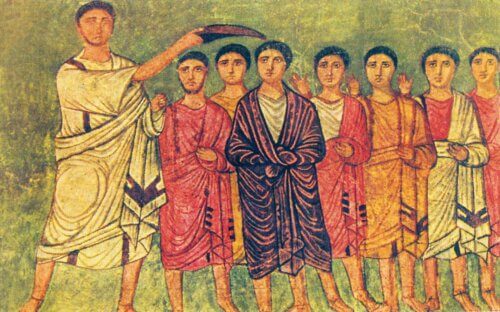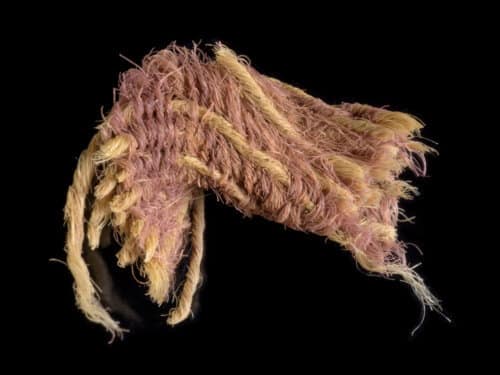In a joint study by the Antiquities Authority, Tel Aviv University and Bar-Ilan University, archaeologists unearthed pieces of cloth dyed in the royal scarlet color from the time of Kings David and Solomon.
"Afrion, made for him by King Shlomo-Ma'atzi, Lebanon. Its pillars were made of silver, its cushion was gold, its chariot was crimson; Its interior is filled with love, from the buildings of Jerusalem." (Song of Songs XNUMX:XNUMX-XNUMX)

For the first time in the Land of Israel and in the southern Levant in general, rare evidence of cloth dyed in the color of royal crimson, from the time of Kings David and Solomon, has been uncovered.
As part of a study of the Methmana color textiles that lasted several years, to the surprise of the researchers, remnants of fabric, tassels and wool fibers, dyed in the royal crimson color, were discovered. Direct carbon-14 dating established that the findings date to around 1000 BC - in the Bible, the period of David and Solomon in Jerusalem. The color, which is extracted from snail species in the Mediterranean Sea, more than 300 km away from Mana, is mentioned many times in the Bible and appears in various contexts in the Jewish and Christian tradition. This is the first time that a fabric painted in crimson from the Iron Age has been found in the Land of Israel - and in general in the southern Levant region. The research was conducted under the leadership of Dr. Naama Soknik from the Antiquities Authority and Prof. Erez Ben-Yosef from the Department of Archeology named after Yaakov M. Alkov at Tel Aviv University, in collaboration with Prof. Zohar Amar, Dr. David Iloz, Dr. Alexander Vervak from Bar Ilan University and Dr. Orit Shamir from the Antiquities Authority. The surprising findings are published today in the prestigious journal PLOS ONE. Here is the link to the article:
"This is an exciting and very important discovery," she explains Dr. Naama Soknik, Curator of Organic Artifacts at the Antiquities Authority. "This is the first time that a piece of fabric from the time of David and Solomon, dyed in the prestigious crimson, has been discovered. In ancient times, the scarlet garment was attributed to noblemen, priests and of course kings. The beautiful color of crimson, the fact that it does not fade and the difficulty in producing the color found in the snail's body in a tiny amount - all these made it the most expensive color, whose price was sometimes higher than that of gold. Until the current discovery, we only knew the waste of snails, and fragments of ceramics with paint stains, which were evidence of the crimson industry in the Iron Age, but this is the first time we have direct evidence of the dyed textiles themselves, which were preserved for about 3,000 years."
Prof. Erez Ben-Yosef from the Department of Archeology at Tel Aviv University: "A Tel Aviv University delegation has been excavating in Timna continuously since 2013. Thanks to the extreme dryness of the place, we also manage to find organic materials such as fabrics, ropes and skins from the Iron Age, the days of David and Solomon - a collection that gives us a unique glimpse of life in the biblical period. Even if we dig another hundred years in Jerusalem, we will not find textiles from 3,000 years ago. The preservation at Timna is outstanding, and is comparable only to much later sites such as Masada and the Bar Kochba caves. In recent years we have been excavating a new site in Timna called 'Givat HaEbad'. The name may be confusing, since the workers there were not slaves at all - but expert deaf people. Timna was the center of copper production, the oil of the Iron Age. The production of copper required advanced, and probably secret, metallurgical knowledge, and those who possessed this knowledge were the 'high tech' of the time. Givat HaEbad is the largest copper mining site in the Bekaa and is full of piles of industrial waste, such as slag from the smelting furnaces. In one of these piles we found three painted pieces of cloth. The color immediately caught our eye, but we did not believe that we had found real crimson from such an early period."
According to the researchers, true crimson was produced from three species of snails living in the Mediterranean Sea: blunt-spined crimson, single-spined crimson and red-mouthed crimson. The color was extracted from a gland located in the snail's body through a complex chemical process that lasted several days. Today, it is accepted by most researchers that the two prestigious colors, crimson and light blue, were produced from the crimson snail under different conditions of exposure to light. When exposed to light, the blue shade is obtained, while without exposure, the crimson shade is obtained. These colors are mentioned many times side by side in sources, and both have symbolic and religious importance to this day. The priests in the Temple, David and Solomon, the Christian Jesus - all wore, according to the narrator, clothes dyed in crimson.
The analytical tests conducted in the laboratories of Bar Ilan University, along with the painting reconstructions made by Prof. Zohar Amr and Dr. Naama Soknik, can indicate the species they used to dye Timna textiles and the shades they wanted to achieve. For the purpose of reproducing the coloring in the scarlet snails, Prof. Amr traveled to Italy, where he cracked open thousands of snails (which the Italians eat) and extracted from their color glands a substance that was used for hundreds of attempts to reconstruct the ancient coloring. "The practical work took us back thousands of years," says Prof. Amar, "and allowed us to better understand hidden historical sources related to the prestigious colors of light blue and crimson."

The color identification was done with an advanced analytical device (HPLC) and indicated the presence of unique color molecules, which only come from those species of snails. According to Dr. Suknik, "Most of the colored textiles found in Timna, including in the archaeological research, were dyed using different plants, which were available and easier to dye. Using animal dyes was considered much more prestigious, and was used as an important parameter, which testified to the economic and social status of the wearer. The remains of the scarlet dyed textiles found are the oldest not only in Israel, but in the entire southern Levant. In addition, we think we were able to identify in one of the pieces the double dyeing method, in which two types of snails were advanced, to enrich the color. This technology is described by the Roman historian Pliny the Elder, from the 1st century AD, and the color produced is considered the most prestigious."
Prof. Ben-Yosef identifies the copper mining site at Timna with the biblical kingdom of Edom, which bordered the kingdom of Israel to the south. According to him, the dramatic findings should revolutionize the way we think about nomadic societies during the entire Iron Age. "The new findings strengthen our assumption that Timana was an elite, meaning that the society there was stratified.
In addition, since the origin of snails is in the Mediterranean Sea, this society probably had trade relations with other peoples, who lived on the coastal plain. However, we do not see permanent settlements in the Kingdom of Edom. The kingdom of Edom was a nomadic kingdom. When we think of nomads, it is difficult for us to free ourselves from the parallel to contemporary Bedouins, and accordingly it is difficult for us to imagine kings without magnificent stone palaces and walled cities. But under certain conditions, even nomads can create a complex socio-political structure, one that the biblical writers could recognize as a kingdom. Of course, this whole discussion throws back on Jerusalem. We know that the tribes of Israel were originally nomadic, and that the settlement process was long and slow. Archaeologists are looking for King David's palace, but it is possible that David did not express his wealth in magnificent buildings, but in a way that is more suitable for a nomadic heritage, such as in fabrics and objects." According to Ben-Yosef, "It is a mistake to assume that if there were no magnificent buildings and fortresses, the biblical descriptions of the United Kingdom in Jerusalem are necessarily literary fiction. The new research in Timana showed us that even without such buildings, there were kings in our region who ruled over complex societies, formed alliances and trade relations and fought each other. The expression of the wealth of a mobile society is not measured in stone palaces and monuments, but in things that were no less valuable in the ancient world - such as the copper that was mined in Timna and the scarlet that was traded with the copper producers in Timna."


6 תגובות
Being a snail at Bar Ilan University is truly a terrible misfortune.
Being a snail 3000 years ago is probably even less than that.
The novelty for me is the knowledge that actually crimson is... purple.
As a former designer - this is a tragedy
As a current programmer it's just interesting.
In any case, as of this time I thank Hashem, Shechem and Arab
I did not smoke a snail (at Bar Ilan University)
In any case, even on the map provided by the researchers, the area was in the territory of the Kingdom of Edom.
Why would remnants of such expensive cloth be found in a copper mining waste site? Maybe the crimson was also produced from minerals of the red rocks in the area?... There are cave paintings that are tens of thousands of years old with red color in the paintings.... It is clear that all the information in the article is very interesting and true, but precisely because of this area - perhaps there is another option for the production of the color.
The find must be hermetically separated from the Israeli royal house completely, what's more, there is no historical connection between the find...
The above finding is important and worthy of its own merits for many reasons.
It should be noted by the way that the production of colors both from the bottom of the sea and from the land appears quite a bit in the literature of the sages and in my opinion a profitable industry was created here in the production of the crimson color for the Roman togas
.
Interesting but in my opinion on the fringes of science. It is intriguing on a gossipy level to know who the snail is and how they created the color. But all of this is swallowed up in fictitious stories about literary figures who did not exist and were not created such as David, Saul and Solomon. The link between science and folktales should emphasize that these are folktales.
ok… and?